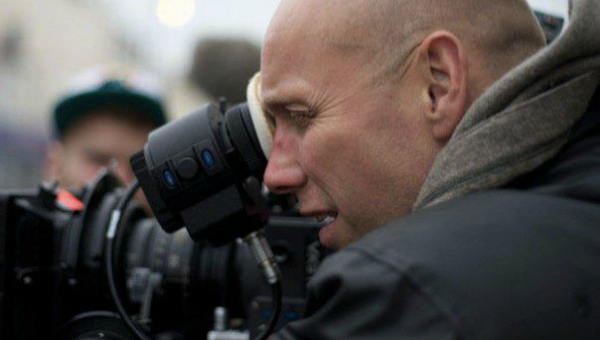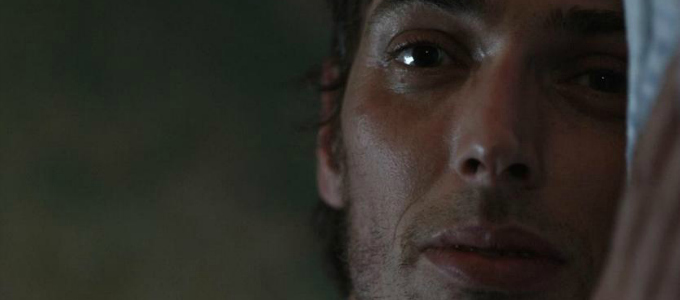Richard Heslop attended Cambridge Film Festival in 2008, when his work was screened as part of a strand devoted to artistic affilates of Derek Jarman strand. Jarman first encountered Heslop at a Brixton Academy event organised by Genesis P. Orridge, where William Burroughs and Bryon Gysin delivered readings and Heslop himself was doing a multi-screen projection piece with industrial post-punk band 23 Skidoo. Heslop went on to work as a camera operator for several of Jarman’s films, including THE GARDEN, THE LAST OF ENGLAND, and IMAGINING OCTOBER, and soon the young film school graduate was given his first paid commission: a music video for the Smiths’ THE QUEEN IS DEAD.
httpvh://youtu.be/Wz5IFl7uCis
“I was so lucky to have met Derek at that time and to be trusted to film for him,” says Heslop. “I loved working with him, and he taught me a lot about making the process as fluid and creative as possible, especially on set. I miss him a lot. With Derek it was very much a group creative process: we were all given a chance to experiment and add to the creative mix, which was very liberating and exciting at the time.”
“The gap between the haves and the have nots is getting wider …”
Heslop documented the Brixton Riots in 1981, and in the lead up to the 2011 riots he was editing FRANK in the east end of London. “The gap between the haves and the have nots is getting wider,” says Heslop. “Although both riots were triggered by a violent police action, they were very different beasts. I think a lot of the rioting in the 2011 riot was organised looting and the original anger at the police shooting got lost in the feeding frenzy – and that it just added to the unease still lurking in the inner cities. I don’t know if anything has changed for the better; I don’t think it has. There’s still mass unemployment, and house shortages and the population is steadily rising. It’s going to get worse, I think. And the Tories definitely aren’t helping with their policies.”
httpvh://www.youtube.com/watch?v=AkYWJ7Q1XR4
One of Heslop’s best known music videos was the Shamen’s Ebenezer Goode, starring the brilliant magician/comedian Jerry Sadowitz. “We filmed with Jerry for 2 days,” says Heslop. “It was the band’s idea to use him, which was an inspired idea. I remember sitting down with him in a Chinese restaurant after the first morning’s shoot, and he explained to me why he hated everybody: ‘Name anyone and I’ll tell you why I don’t like them’. I think he meant it. I was used to difficult people, I’ve met much worse. I liked him by the end of the shoot. We never expected it to get to number 1 in the charts – they were good times. I haven’t seen him live but have seen videos of his show, he definitely takes no prisoners. I bumped into him a few years ago at a railway station, and he didn’t really want to talk about it, I think he regrets it [laughs]. He was hard work for the first part of the shoot, but as the day wore on, he softened and began to trust us – and I think, by the end of it, he may even have enjoyed the experience.”
“… he may be unhygienic and inadequate, and have mental health issues, but he means well and is a kind man …”
Having worked with such an onslaught of interesting people, Heslop’s production company gave him the chance to illustrate his own stories for a change. He named “I Like Films, Me” after a carpet shop he saw in Newcastle while location scouting for FRANK. “The script writing was much easier than I thought,” says Heslop. “In fact, I wrote much too much dialogue, which we had to cut out in the edit.” Once he had the basic idea for the Frank character, the rest of the story fell into place. “I treated writing like therapy,” says Heslop. “I would spend 5-6 hours a day writing, then take a few days off to let the dust settle.” However, it was the worst of times for film makers in London, and it was Northern Film and Media who finally offered funding. “We shifted the locations up North,” says Heslop, “and thank god we did, because it’s visually wonderful up there and the people were brilliant.”
Darren Beaumont brings a haunted, delicate beauty to the character of Frank. Some actors had turned down the project because they perceived the character as bleak and unlikeable. The little-known Beaumont was the only person who auditioned for the part, and he proved them all wrong. “As soon as he walked in, I knew he was the man for the job,” says Heslop. “All we had seen of him was a short film in which he said virtually nothing, but there was something about his physical movement and face that drew me to him – he had the vulnerability and physique I was looking for. He hadn’t done much film work at all, in fact he trained as a butcher and had come to acting quite late. He gave his all to the part, there was nothing he wouldn’t do. He never moaned or complained, and I really hope other directors see his potential because he’s brilliant. It’s so hard being an actor, but he really got under the skin of Frank, and without his rock solid, sensitive, vulnerable and likeable performance the film just wouldn’t have worked. Frank is almost Dickensian in his character: he may be unhygienic and inadequate, and have mental health issues, but he means well and is a kind man. It’s the pressures of the outside world and his own self doubts in the form of the Poly and Fidel characters that turn him into the emotional mess he becomes.”
“I was not a happy bunny when I started writing FRANK – I used it as a kind of therapy to exorcise my demons.”
FRANK’s bleak beauty and baroque squalour bring to mind Cronenberg’s SPIDER (which Heslop has not seen), but it was a true story which inspired Heslop’s fairytale. “The initial idea came from an idea I’d had an idea rattling around my head for many, many years, to do with the serial killer Dennis Nilsen,” he says. “What interested me about his case was the way he had set up his macabre home life with the bodies. Watching television with them, talking to them, eating with them – it was like he had his own family, except of course he’d killed them to keep them.” Heslop didn’t want to make a serial killer movie – Frank craves company, and conjures his undead friends from the depths of his warped psyche, only for them to turn on him, and force him to confront his own neuroses. Heslop compares the ironic fulfilment of Frank’s deepest longing to W.W. Jacobs’ terrifying short story, The Monkey’s Paw.
Heslop’s artistic influences include Dickens, Tarkovsky, Lynch and Tarr, but FRANK was primarily a cathartic outlet for a troubled artist. “I was not a happy bunny when I started writing FRANK,” says Heslop. “I used it as a kind of therapy to exorcise my demons. That’s the great thing about writing and art, it’s an extension of the inner workings of the writer. I was also reading in the newspapers, over the years, many stories of people who have secretly lived with dead bodies either because they can’t bear to part with them, or they are collecting their housing benefits, or pensions or are afraid they will lose their flat if they confess to the death. It’s much more common than you realise.”
Frank’s Newcastle is heavily inspired by Heslop’s memories of living in London in the 1960s. “I grew up playing in building sites, and ‘bomb sites’ as we called them,” he says. “So I love textures of decay and industrial landscapes.” The location for Frank’s bedsit interior was the servants’ rooms of an abandoned 17th century townhouse, which came complete with peeling wallpaper and accumulated debris. Set designer Anthea Nelson helped Heslop to furnish the flat with the trappings of an obsessive compulsive hoarder, from jars of pee and charity shop tat to rancid tins of “fleishklumpen” (pictured below).
“…we felt that the outer chaos of Frank’s flat should reflect the interior distress and chaos of his soul.”
“We found a complete collection of clown figurines in a charity shop that we thought fitted into his world,” says Heslop. “Anthea also had some wonderful photo books of the damage to house interiors after Hurricane Katrina had destroyed them, and we felt that the outer chaos of Frank’s flat should reflect the interior distress and chaos of his soul.” He also worked very closely with the art department and prosthetics department, who created a wonderfully decadent and authentic decomposition for Frank’s deceased chums on a surprisingly low budget. “We made [Fidel’s] body hollow, so we could get the camera inside the torso to be able to see Frank working on his not very good stuffing and stitching from the inside out,” says Heslop. “I wanted that P.O.V. and the SFX team did us proud. Sound also played an important part in the visceral feel to those scenes, as we used ‘real’ sounds for the squelching and sloshing. Nigel Holland supplied the great unsettling sounds in Frank: he has a massive sound archive of real guttural autopsy of a dead pig sound effects. They were very useful.”
The mollusc motif in FRANK evokes Crispin Glover’s “What Is It?” and the child snail collector in FRANK is based on Heslop junior. “The reason I used snails, apart from the fact that they are so fragile and beautiful,” says Heslop, “is that my own 7 year old daughter used to collect snails and carry them around with her, and so I took the idea from watching her. I love the fact that snails are all over the place but we almost don’t notice them, we are so used to them, but if you look real close they are amazing, a bit like the character Frank and his micro-world. I also liked the idea that because they are so fragile it’s the sort of thing that Frank would find hard to look after. And that they move so incredibly slow, they are almost like life on a different dimension. While Frank’s life is happening on one level, the snail’s life is happening on another… life goes on, with or without you.”
FRANK is showing at Cambridge Arts Picturehouse at 8.15 pm on 19th September, and Richard Heslop will be attending for Q&A after the screening. Buy tickets here.





nice xxx
HELLO, GUESS WHO I AM, CLUE= HUGE FAN ?????????????????????
ITS AN ABSOLUTE WORK OF BRILLIANCE, THE FILM IS VERY FUNNY, WELL PUT TOGETHER, AND GREAT ACTING FROM “FRANK” CHARACTOR MAKES IT EXTREMELY GOOD VIEWING, ALSO EASY TO RELATE TOO, EVERYONE HAS MET SOMEONE LIKE POOR FRANK…………….GREAT MOVIE
Brilliant – absolutely splendid – Cambridge is gonna Rock!!!
Excellent! The man is a genius.
hello darling, when can we see it in berlin? they will love it over here!
Great post.
Nice post!
Thanks for the great article